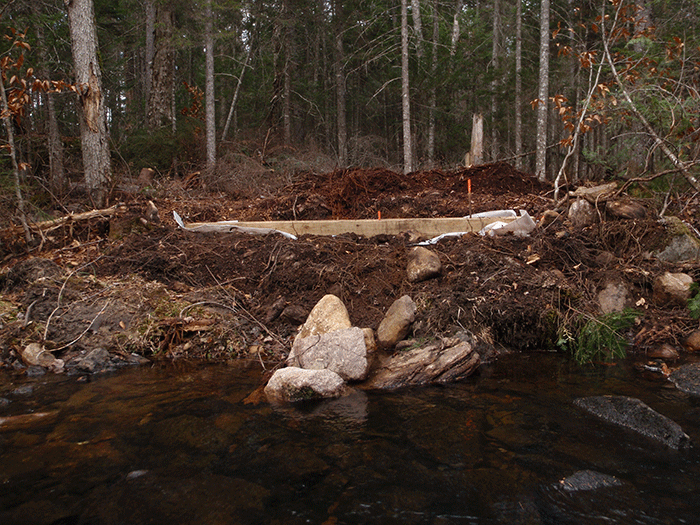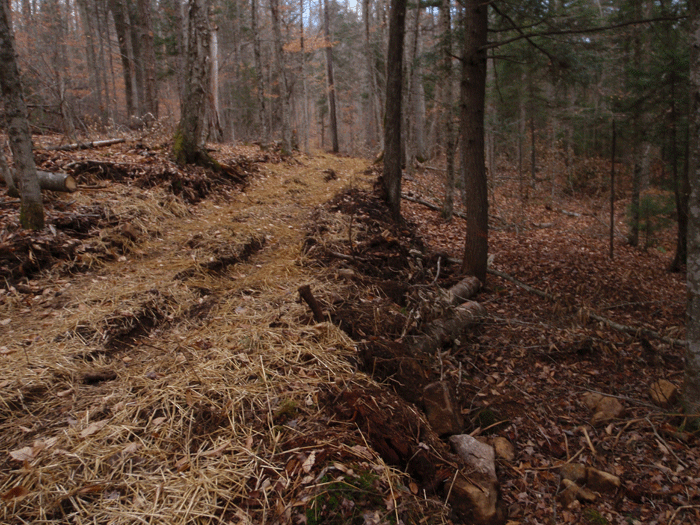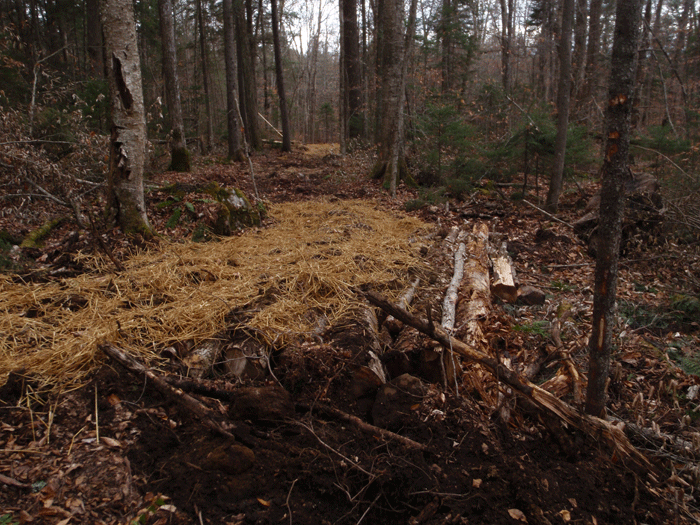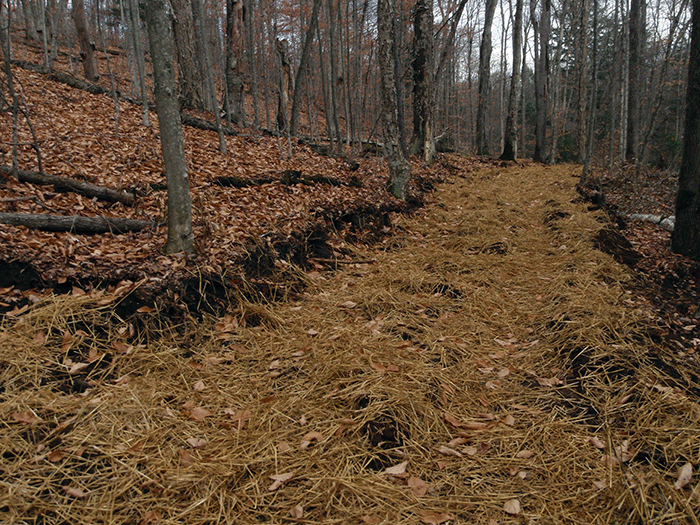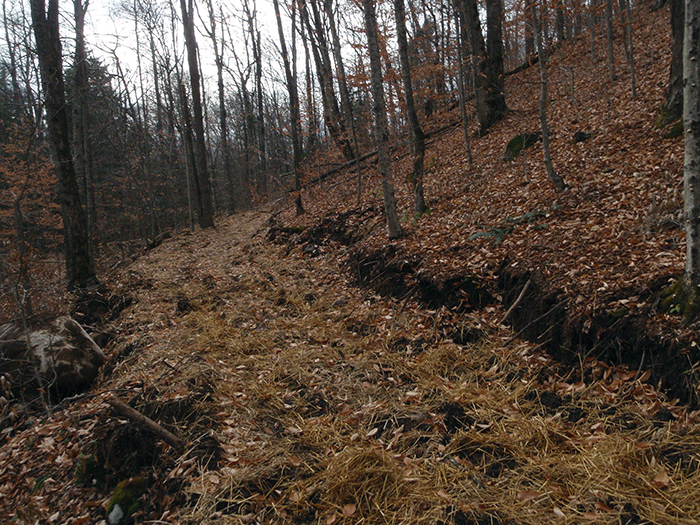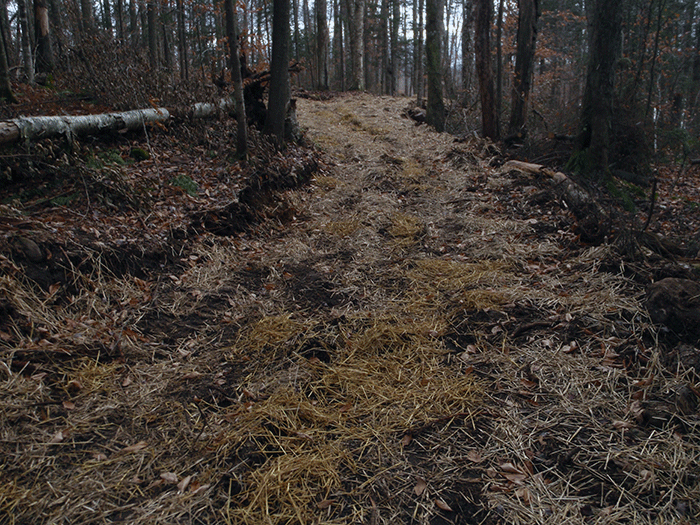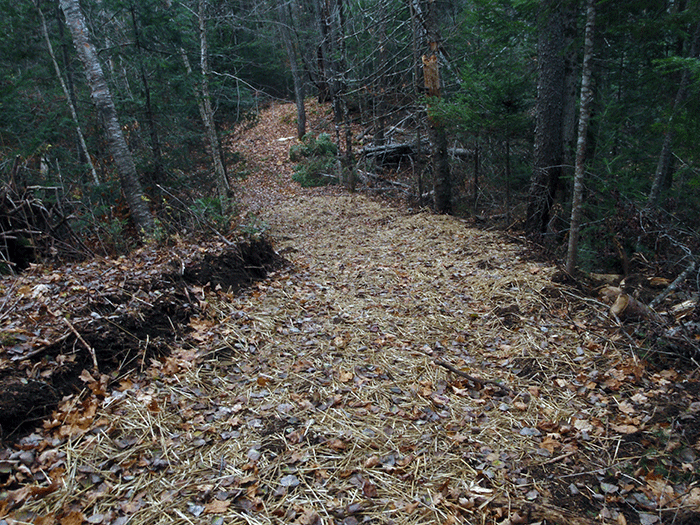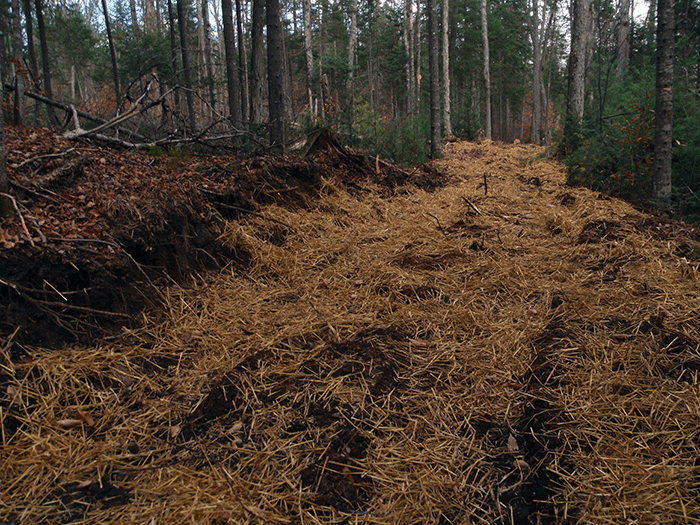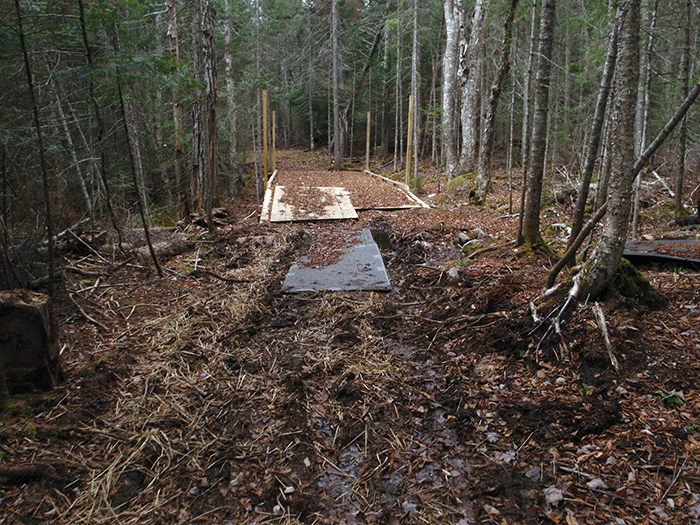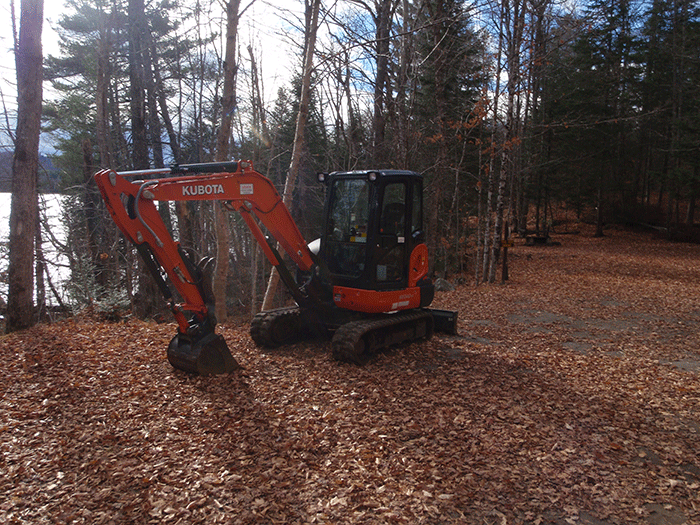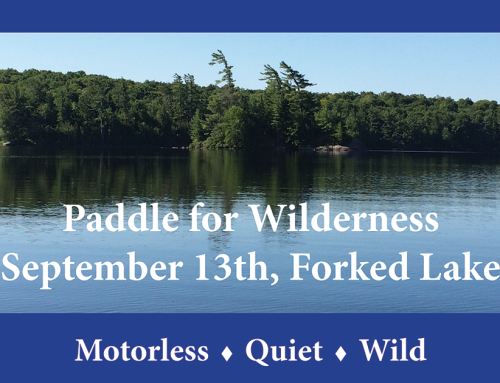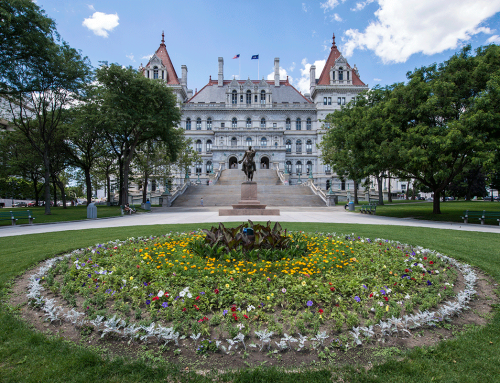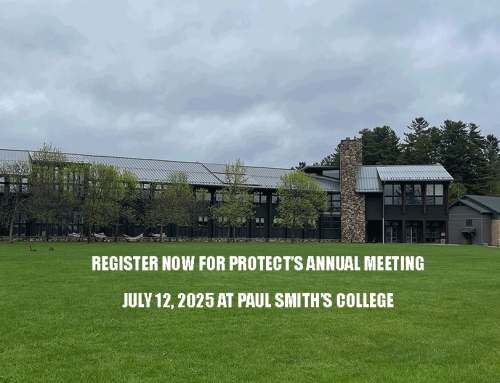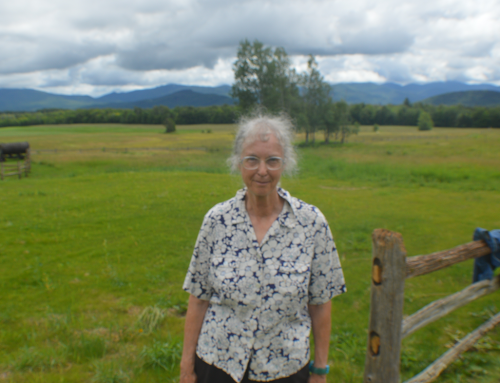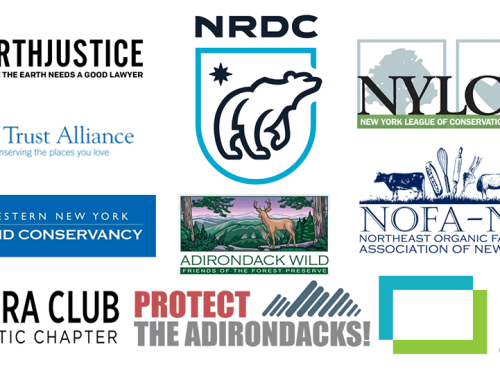Protect the Adirondacks inventoried the newly constructed class II community connector snowmobile trail around Harris Lake. This trail was approved by the Adirondack Park Agency (APA) and Department of Environmental Conservation (DEC) in July 2015 as part of a new Newcomb to Minerva snowmobile trail connection. The trail runs just over 1 mile through parts of Forest Preserve in the Santanoni Historic Area, Vanderwhacker Mountain Wild Forest Area, and Harris Lake Intensive Use area. PROTECT found the work on this trail to consistently violate the 2009 Management Guidance: Snowmobile Trail Siting, Construction and Maintenance in Forest Preserve Lands in the Adirondack Park (Guidance), Adirondack Park State Land Master Plan, DEC’s Stormwater Pollution Prevention Plan permit issued for this project, and the DEC guidelines for snowmobile bridge construction. There may also have been wetlands violations.
It’s a sad commentary on the state’s management of the Forest Preserve that after a number of years of building these types of trails, and a variety of state policies and Guidance documents designed to ensure proper management to protect the Forest Preserve, serious problems persist in the construction of these trails and natural resource damage is inflicted upon the Forest Preserve.
The Guidance places strong emphasis on “proper trail layout” in order to prevent natural resource damage and to limit the use of damaging construction methods, such as trail leveling, grading and bench cutting with heavy machinery. All of these heavy-handed activities were deployed with abundance along the Harris Lake trail, which raises questions about the decision making that saw fit to route such a trail through this part of the Forest Preserve in the first place.
The Guidance requires that the construction of class II community connector trails preserve a “trail-like character.” The State Land Master Plan requires that snowmobile trails retain the “character of a foot trail.” The pictures below show extensive natural resource damage all along the Harris Lake trail. These pictures illustrate the many ways that class II community connector trails are far more road-like than trail-like.
Requirements of the Guidance and State Land Master Plan for trail-like conditions for snowmobile trails, on which high speed motorized recreation occurs, is in many ways a ferry tale. Even in the best conditions in the field and with scrupulous work by APA and DEC staff during trail planning and construction, the requirements of class II community connector snowmobile trail construction cause dramatic changes to the Forest Preserve. When this work is undertaken in challenging or unsuitable terrain on the Forest Preserve or construction work fails to comply with APA-DEC standards, the result are very poor indeed. Sadly, this is the case with the new Harris Lake trail.
Protect the Adirondacks calls upon the APA to investigate these abuses and launch an enforcement action for the numerous violations of existing trail construction policies and standards. This level of abuse and the flagrant violations of core Forest Preserve laws, management policies, and regulations should not be tolerated.
Click here to see PROTECT’s letter to the APA calling for an investigation of serial violations on the new Harris Lake trail.
Numerous Violations of Trail Width Standards: The Guidance set trail width standards for class II community connector trails at 9 feet in straight areas and 12 feet on curves or slopes. In many places on the Harris Lake trail the width of the trail surface is far in excess of these standards.
The Guidance states “Class I and II trails wider that their classification allows will be actively restored to these limits.” (P. 9) The pictures below amply show that on the Harris Lake trail these standards were not upheld. Areas of the Harris Lake trail that exceed trail width standards should be rehabilitated.
The Guidance states construction work for class II community connector trails should “preserve a trail-like character.” The Guidance calls for making decisions in the field to utilize the “minimum requirement” that will not result in a “potential degradation of the wild forest setting.” (P. 7-8) The pictures below show a trail that is much more road-like than trail-like.
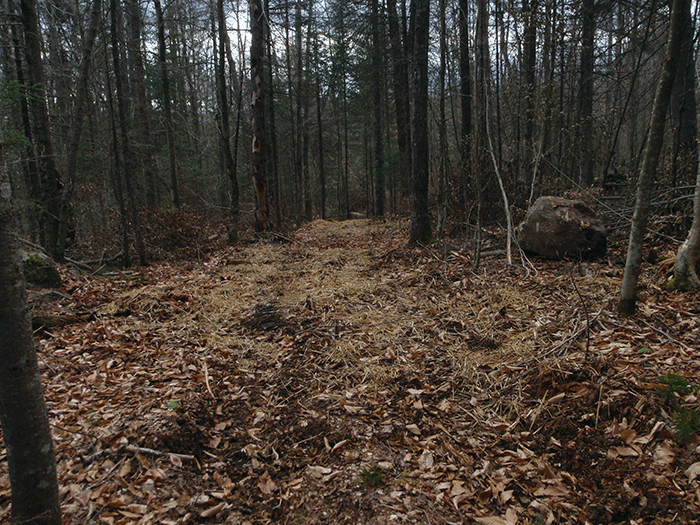
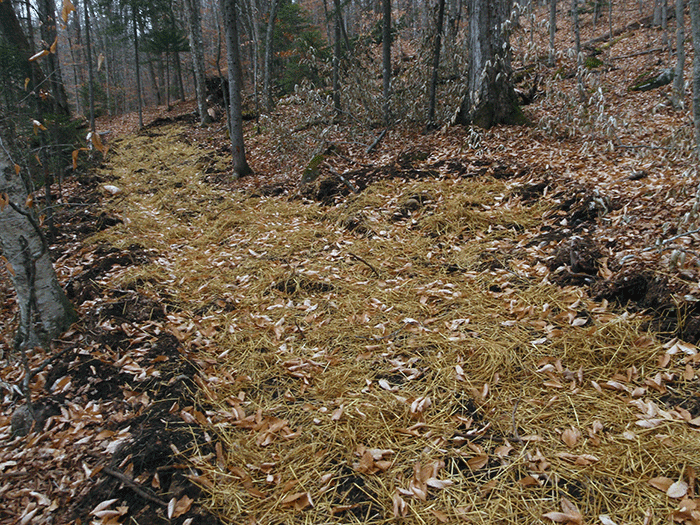
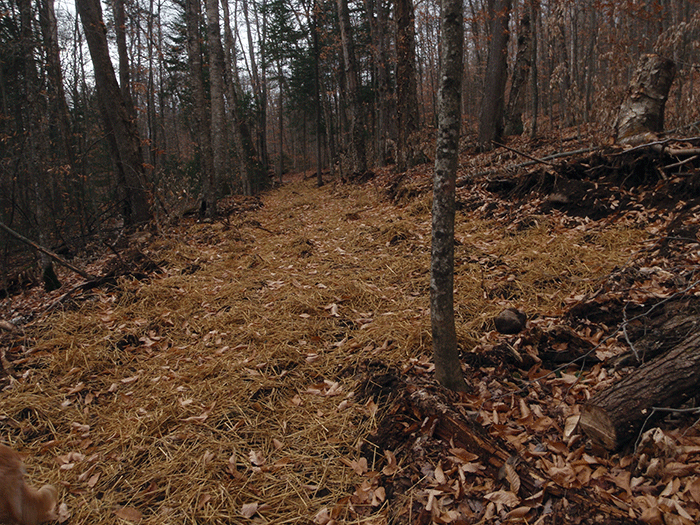
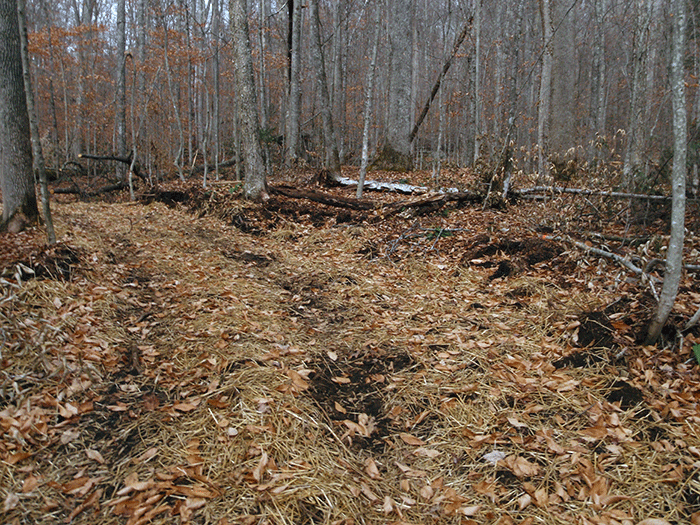
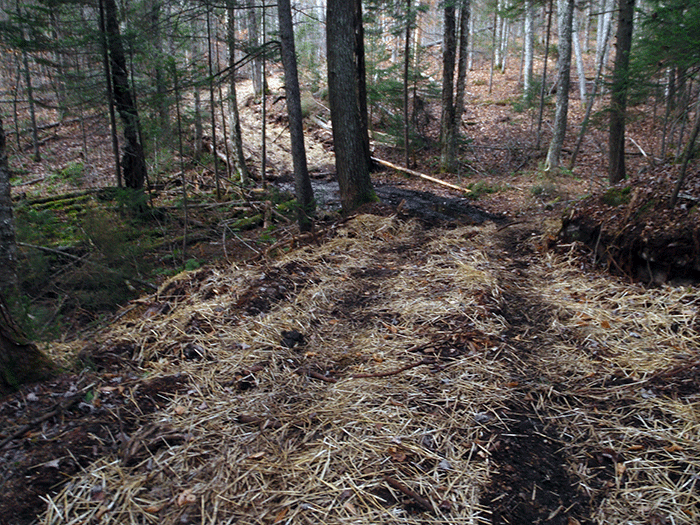
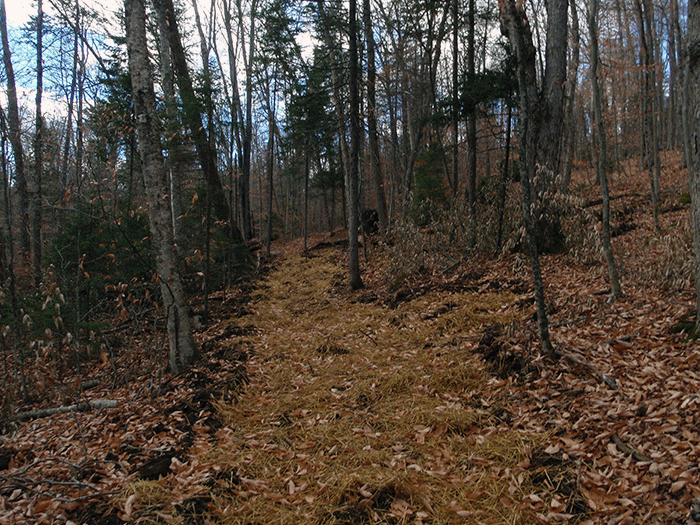
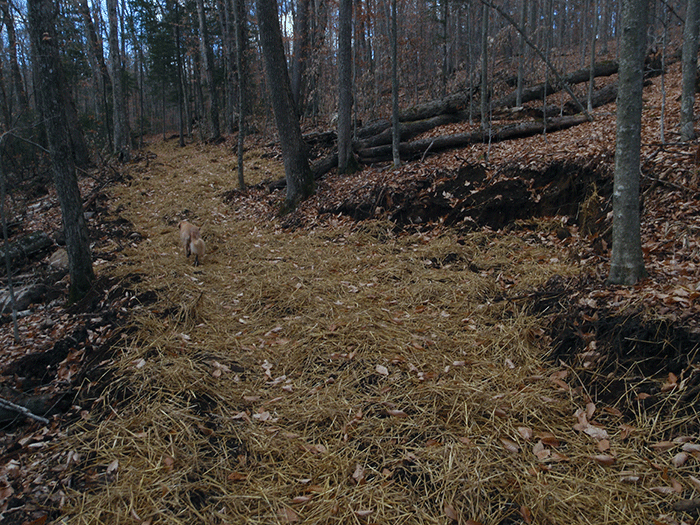
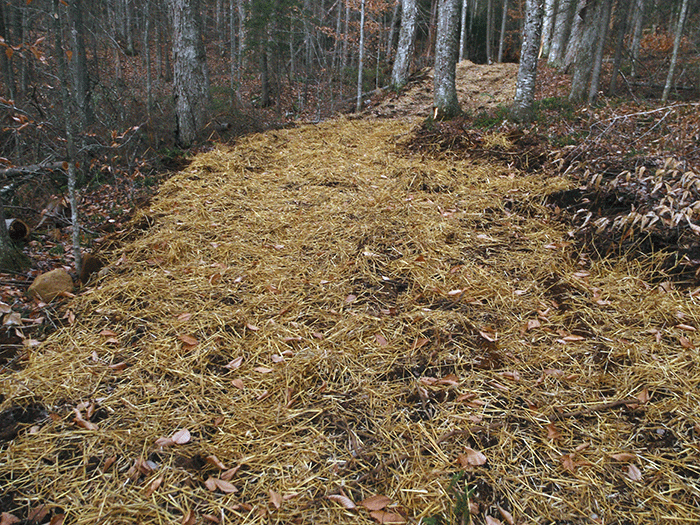
[caption id="attachment_9518" align="alignleft" width="700"]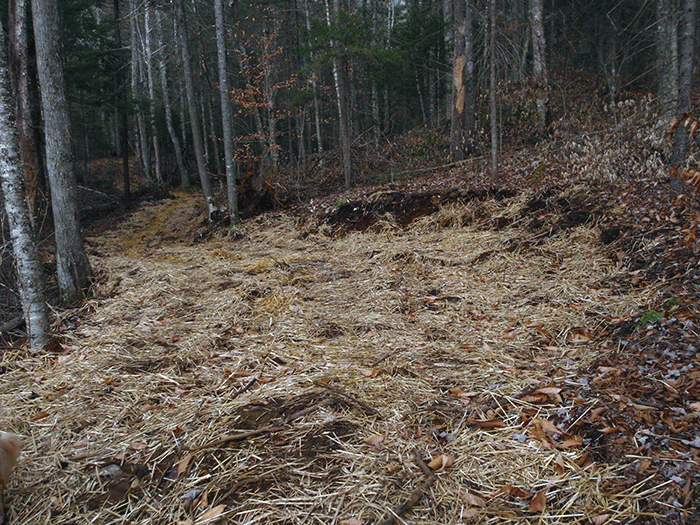 The pictures above show a series of locations along the new class II community connector snowmobile trail to Harris Lake that are well over the allowable 9-12 foot trail width limits required under state policy.
The pictures above show a series of locations along the new class II community connector snowmobile trail to Harris Lake that are well over the allowable 9-12 foot trail width limits required under state policy.
Wetland and Stormwater Violations: PROTECT’s field visit found a DEC Stormwater Prevention Plan (SWPPP) permit nailed to a tree at the Camp Santanoni end of the Harris Lake trail. Unfortunately, we encountered snowmobile bridges being constructed over permanent streams with heavy flows where there was disturbed and exposed soils along the stream banks with no silt fencing whatsoever. PROTECT found instances where ATVs and heavy tracked machinery were repeatedly driven through a wetland with no mats or protection for the wetland. We found snowmobile bridges being constructed within intermittent streams, with active flow, where there was disturbed and exposed soils within the stream corridor with no silt fencing.
The Guidance states that “Any activity in a wetland or that may impact a wetland will be undertaken with prior consultation with the APA and with recognition of Army Corp on Engineers’ permit requirements.” (P. 12) If “prior consultation” was undertaken between the DEC and APA, did the APA approve construction activities that involved no use of silt fencing in stream corridors and repeated driving of various motor vehicles through a wetland? It appears that there were stormwater and wetlands violations during the construction of the Harris Lake trail.
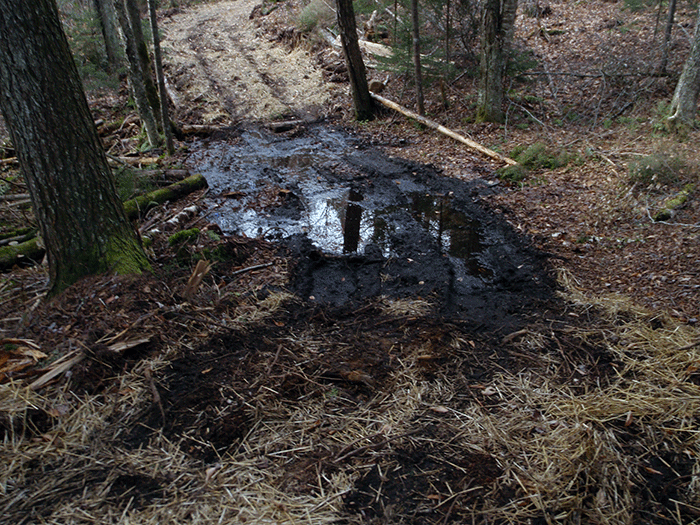
[caption id="attachment_9470" align="alignleft" width="700"]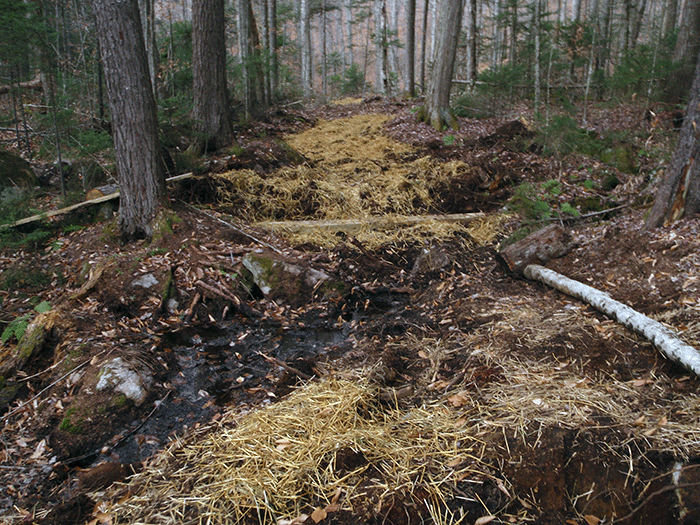 The new class II community connector snowmobile trail around Harris Lake appears to have violated stormwater management permits and state wetland laws. The top picture shows an area on the new trail where a 12-foot-wide bridge is being built. The stream bank has been torn up, there is exposed soil, and no silt fencing was in place. The middle pictures shows a wetland through which heavy machinery has been driven repeatedly. The bottom picture shows a intermittent stream corridor where another bridge is being built. Here, work crews are building a bridge within the stream corridor with no protections for the stream.
The new class II community connector snowmobile trail around Harris Lake appears to have violated stormwater management permits and state wetland laws. The top picture shows an area on the new trail where a 12-foot-wide bridge is being built. The stream bank has been torn up, there is exposed soil, and no silt fencing was in place. The middle pictures shows a wetland through which heavy machinery has been driven repeatedly. The bottom picture shows a intermittent stream corridor where another bridge is being built. Here, work crews are building a bridge within the stream corridor with no protections for the stream.
Debris Clutters Trail Corridor: The Guidance states “When removed boulders and rocks are not buried, but instead set to the side of the trail, they will be dispersed with care and not left in windrows or pile next to the trial.” (P. 10) The Harris Lake trail is rife with debris piles alongside the trail.
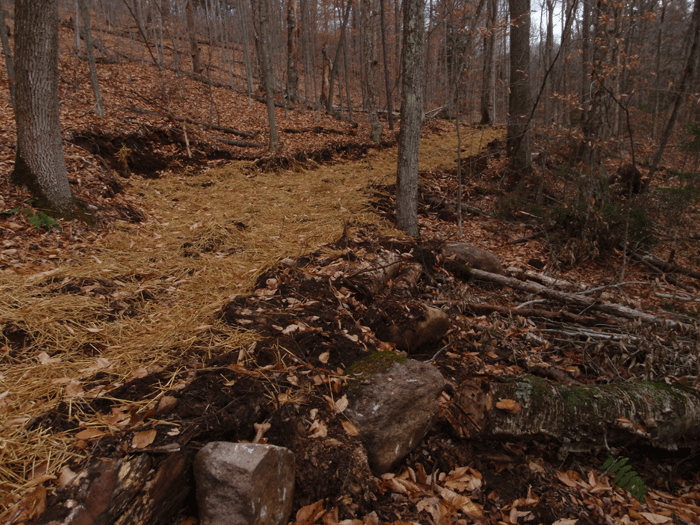
These three pictures show windrows of boulders, cut trees, stumps and other debris lined alongside the Harris Lake trail. The Guidance calls for care in this work. Many part of this trail have a hardened trail edge lined with boulders and debris.
Harris Lake Trail Area Significantly Altered by Trail Construction: The Harris Lake trail was significantly changed by construction activities, including substantial leveling, grading and bench cutting. All of these activities substantially change the character of the trail corridor and the Wild Forest atmosphere. It’s important to realize that when these activities occur all trees and all forest understory are removed from the trail corridor, soils are compacted, and the complex duff layer of the forest floor is destroyed. The Guidance contemplates that such heavy-handed activities should be used sparingly.
The Guidance states “Limited leveling and grading may be undertaken using appropriate low-impact landscaping equipment as specified in a Work Plan.” (P 10) More than half of the Harris Lake trail corridor was substantially graded. If such a high proportion of a trail requires grading to make it safe for snowmobile riding, then it would seem that that area is unsuitable for a snowmobile trail. The Guidance talks of “limited leveling and grading.” What we found on the Harris Lake trail was nearly continuous major leveling and grading.” The sheer extent of leveling and grading on the Harris Lake trail violated the spirit and letter of the Guidance.
The Guidance also states that on Class II trails “Trail surfaces should generally follow the existing contours of the natural forest floor and not be graded flat.” (P. 10) The Harris Lake trail was almost continuously graded flat.
In addition to widespread leveling and grading on the Harris Lake trail, extensive bench cuts were made. The Guidance states “The need for bench cuts will be minimized through proper trail layout. The tapering of side slopes will be allowed outside the cleared trail width.” (P. 11). Note that oftentimes bench cuts are 2-3 feet in width, but this distance is not considered part of the 9-12 foot trail width limit. Under the Guidance, therefore, a 15-foot or more cleared trail corridor area is permissible.
On the Harris Lake trail, bench cutting (as shown in the pictures below) was used on a very high percentage of the total trail, upwards of one-third or more. This high use of bench cuts hardly meets the Guidance requirement for “proper trail layout” and points to a part of the Forest Preserve unsuitable to provide a motorized recreational trail experience.
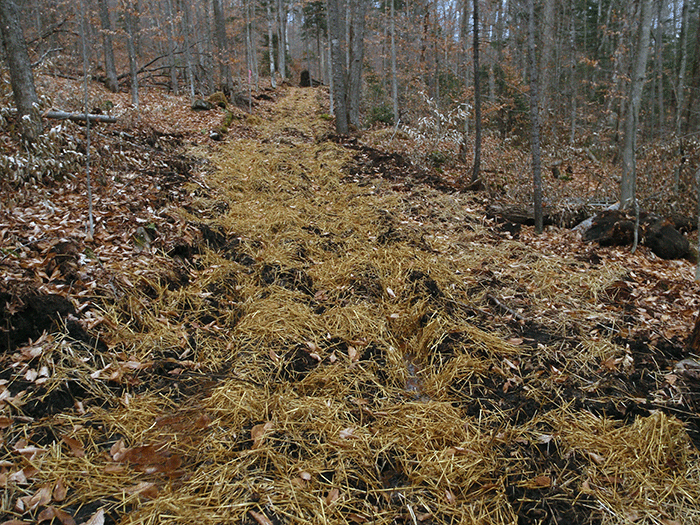
The pictures above show the vast amount of leveling and grading undertaken on the Harris Lake class II community connector snowmobile trail. State snowmobile trail policy states that leveling and grading should be limited, yet on this has become standard practice for construction of these types of trails. The trail surface on the sections of the Harris Lake trail shown above have been severely damaged through grading.
Work Continued After Work Season Detailed in Guidance: The Guidance states a strong preference that work on snowmobile trails that involves motor vehicles and heavy equipment should be undertaken in “August, September and October.” (P 13) Such work on the Harris Lake trail went far into November.
New Style of Snowmobile Bridge: The DEC has installed a new type of snowmobile bridge along the Harris Lake Trail. These bridges employ high 8-foot posts at all four corners of the bridge. This feature is not commonly used elsewhere and such posts are not featured in snowmobile bridge design documents.
Shibboleth of the “Multi Use Trail”: The changes to the Harris Lake trail are profound and will be longstanding. The changes have made this trail corridor highly unattractive for hiking and impractical for bike riding. This trail will be ugly to walk on given the degraded state of the corridor and the extensive alteration of the trail surface makes it impossible to ride a bike on. The extensive leveling, grading, bench cutting, windrowing of rocks and boulders and debris on the trail sides, extensive tree cutting, total destruction of the forest understory, and changes to the hydrology of the trail area so that the water stands throughout the trail surface makes any other use other than wintertime snowmobiling impractical and uninviting for the general public. The APA and DEC have embraced the concept of the “multi-use” trail, yet the Harris Lake trail provides a good example where the Forest Preserve is so heavily disturbed with extensive terrain alterations that few will use this trail except those driving snowmobiles (and that’s when there’s snow, which is far less in this area than the western Adirondacks).
“Appropriate Low Impact Landscaping Equipment:” The Guidance calls for use of “appropriate low impact landscaping equipment” for all bench cutting, grading, and leveling work. The pictures below shows the what state agencies consider to be this kind of equipment.
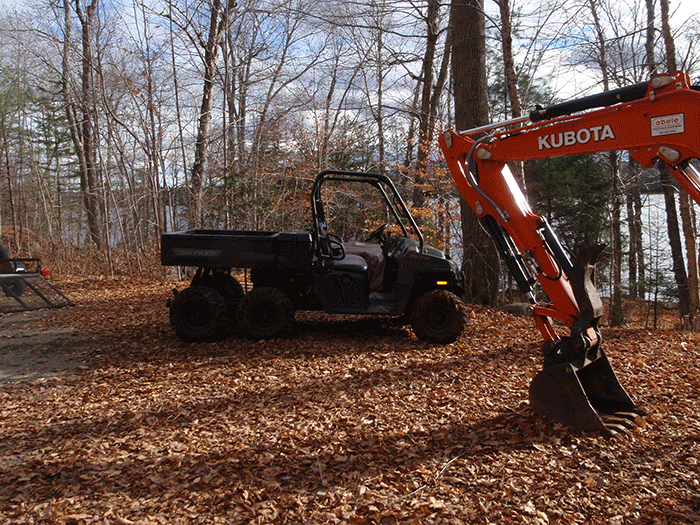
The top picture shows what the DEC and APA say is “appropriate low impact landscaping equipment.” This heavy equipment impacts and compacts the trail surface. This ATV in the lower pictures was used to haul supplies and people up and down the new class II community connector snowmobile trail to Harris Lake. This stands in stark contrast with how supplies and people are transported for construction of a foot trail.
At One Time the APA Acted Independently to Hold the DEC Accountable for Forest Preserve Management Violations: At one time the APA did hold the DEC accountable for violations of Forest Preserve laws, policies and regulations. When APA Counsel James Townsend was a Commissioner, four snowmobile trails that were heavily abused and degraded during trail construction were subject to APA enforcement actions and rehabilitation efforts were undertaken on these trails.
The abuses all along the Harris Lake trail merit this type of action by the APA to hold the DEC accountable.

